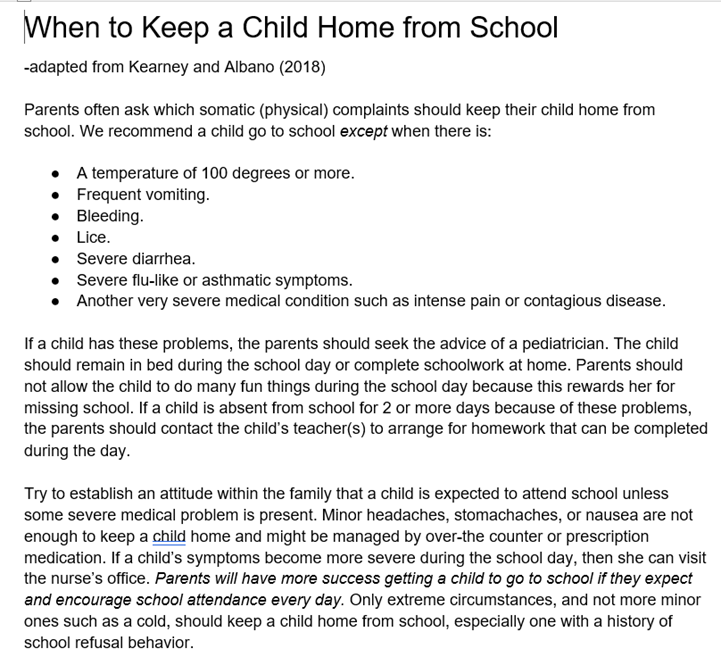Spring is supposed to bring joy and renewal, but for some, it can trigger feelings of depression and anxiety. Learn how to manage these symptoms and boost your mood effectively.
How to Manage Spring Depression and Boost Your Mood
Posted by Dr. Amy Roth on Jun 25, 2025 10:45:31 AM
Remember that school is mandatory. State law (Act 138) requires all compulsory age (6 years-18 years) children to attend school. Easier said than done! Some children have VERY REAL difficulties getting to school. It is an internal fight for many children. Children with school refusal behaviors are having a physical response to the perceived fear. Naturally our brains protect us (fight, flight, freeze) from danger, but school is not the enemy. Our anxiety is over reactive and is the actual enemy.Good news! Anxiety can be managed. We can learn technigues to help ourselves and our children to gain control.
Topics: ATTEND
You see the signs everywhere! In stores, on commercials, in conversation, and in the mail. And you are probably feeling just as anxious as your child for the return of school. Many parents are anxious about the school year starting again, but it is so much worse when your child has school refusal behaviors. It is more than the typical fear associated with the new teacher, new schedule, new classes, and in some situations new school, and new peers. It is facing challenging behaviors, excuses, and the permeating and very real fear your child is facing when thinking about going to school. It is the shame that accompanies the expectation to attend school, but the knowledge that getting to school is so unattainable. It is the desperation for the anxiety to be fixed, for your child to address the fear, fix the problem, to just be okay. It is the ongoing daily thoughts and worries of your own about your parenting, about your child’s future, and the unanswered call for help. It’s constantly worrying about your child and trying desperately to help only to no avail.
Topics: ATTEND
We are at the summer mid-point. Before we know it, we will be back to our fall schedules.
Did you know about 4%-6% of the US population is affected by SAD (seasonal affective disorder)? I always thought SAD occurred only in wintertime, but it turns out summer with its intense heat, humidity, and longer days can trigger SAD. More women are diagnosed with SAD and many tend to have other MH diagnoses such as ADHD, GAD, eating disorder, panic disorder, bi-polar disorder, or depression. The symptoms associated with SAD in summertime include change of appetite, trouble sleeping, low energy, irritability, agitation, aggressive behavior, weight loss, and anxiety. Check out Web MD for more inclusive information.
How do I fight against summertime SAD?
- Reliable routine. Summer tends to disrupt our schedules and routines. Without the daily expectations of school, students stay up late, sleep late, and fill their day with video games or social media. The unscheduled day leads to unpredictability and disruptions to our diet, exercise, and sleep habits. All of which are essential for a healthy body and mind. Stick to a regular daily routine with good eating, sleeping, and exercising habits.
- Be aware of your worries. Summertime social events typically means less clothing and many tweens and teens are body self. Summertime social events and/or vacations can be costly. Tweens and teens begin to realize financial constraints, and many compare themselves to their peers who are working, socializing, and able to do simple daily tasks (like attend school). Identify and challenge your thoughts for accuracy and truth. Refrain and begin to tell yourself true statements. Seek help to address your worries.
- Set boundaries. Having clear and safe limits provides consistency and reliability in every day. It also provides safety for your child, improves communication, and reduces conflict. Limitations are a part of life and help us to make decisions. Having limitations or boundaries with our teens help them to take on responsibility and learn to live within certain limitations. Set consistent, clear, and specific limits; state your expectations; make consequences known; and most importantly, allow your child to make decisions and face the consequences. Your tween/teen will survive the consequences of their behavior.
- Get help! We are meant to do life together. Share your burden with trusted family, friends, or a professional. Talk to your doctor and learn about medications.
If you have not yet done so, start a routine today. Part of that routine can be preparing for school in the Fall. Yes, it is about time to begin thinking about your expectations for Fall. Consider placing boundaries around your children and develop a routine with clear consequences. Begin exposing your child to the school building again. Start by driving by the school, then into the school lot. Sit together in the car with your uncomfortable feelings. Remind yourself and your child that you can have your feelings and do the task. Eventually, you can get out of the car and stand at the entrance, and then eventually walk around the building.
By working through these exposures to school and sitting in the uncomfortableness, you are teaching your child that (s)he can handle the discomforting feelings. In reality, there is no danger, but there are real feelings of fear. By sitting in the fear with our child and slowly facing the fear, we learn that we are okay and we can handle tough and uncomfortable situations. This means we plan and prepare for uncomfortableness. It’s important to let your child face the fear and feel the anxiousness to learn coping and tolerance. Start small. Go slowly. Very small incremental steps forward is moving in the right direction. The idea is to slowly find the point of tolerance and over time and with lots of opportunities, increase tolerance through exposure and practice. Just as learning an instrument takes time, practice, and patience, so does learning to cope with our discomforting anxious feelings. Of course, we run or hide from anything unpleasant so our children need adults willing to sit (not solve) in and through the anxiety.
For more detailed information, check out our sources.
https://parentandteen.com/creating-safe-boundaries/
https://getparentingtips.com/tweens-and-teens/discipline/setting-boundaries-for-teen-behavior/
https://www.nimh.nih.gov/health/publications/seasonal-affective-disorder




 Employment
Employment News
News Online Store
Online Store Directions
Directions Delays/Cancellations
Delays/Cancellations


